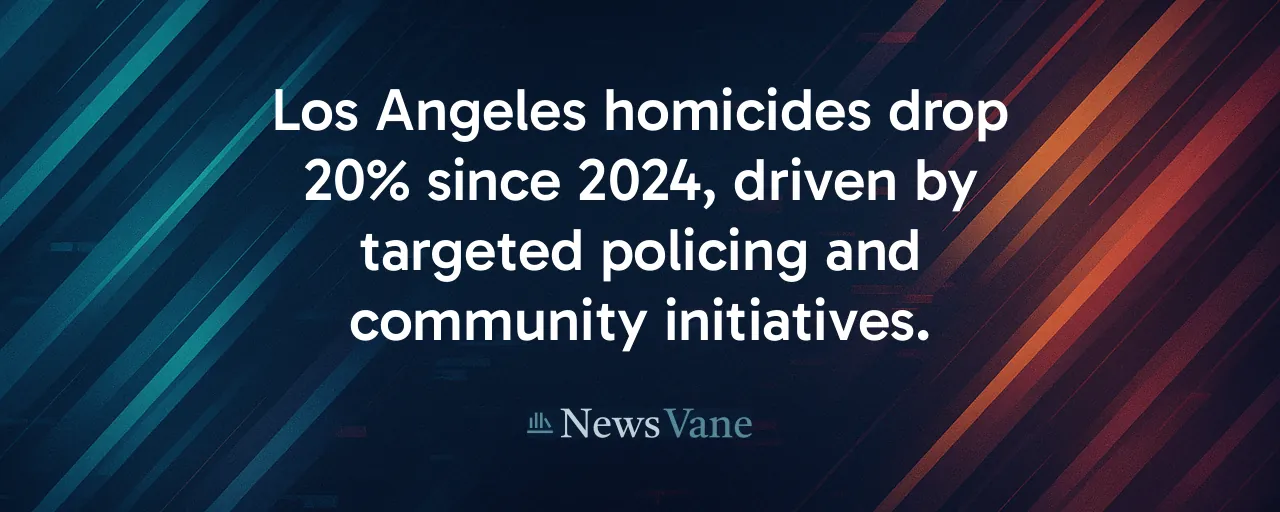A Historic Drop in Violence
Los Angeles is witnessing a remarkable shift. Homicides are on pace to reach their lowest point since 1968, with 116 killings recorded through June 2025, a 20 percent drop from the same period last year. City officials, including Mayor Karen Bass, point to a blend of rapid police response, targeted arrests, and community-based prevention as the catalyst. This milestone arrives as residents, business owners, and policymakers alike demand safer streets amid lingering concerns about property crime and public disorder.
The decline is no small feat for a city that once grappled with over 1,000 murders annually in the early 1990s. It reflects a broader national trend, with major U.S. cities reporting fewer killings in 2024 and 2025. Los Angeles stands out for its multifaceted approach, balancing law enforcement with programs that address violence at its roots. This moment raises a critical question: what strategies are driving this change, and can they sustain it?
Policing With Precision
At the heart of the city's efforts is a refined approach to policing. The Los Angeles Police Department has bolstered patrols in high-crime areas, using data to pinpoint hotspots. A recent surge in Encino, for example, curbed a burglary spree, showing the impact of targeted deployments. Since 2022, the department has added roughly 400 officers, though it remains below its authorized strength of 9,500. Faster response times and strategic arrests have disrupted violent crime cycles, particularly in gang-afflicted neighborhoods.
This focus builds on historical lessons. In the late 1990s, the adoption of CompStat, a data-driven policing model, helped slash homicides citywide. Today's efforts echo that precision but face modern challenges, including recruitment hurdles and public scrutiny over racial disparities in stops. Transparency in crime data and officer conduct remains vital to maintaining trust, especially in communities long skeptical of law enforcement.
Community at the Core
Beyond policing, Los Angeles has invested heavily in prevention. Programs like Gang Reduction and Youth Development (GRYD) target at-risk youth in high-violence areas, offering mentorship and jobs. GRYD zones have seen a 45 percent drop in gang-related homicides since 2023. Meanwhile, Summer Night Lights, which keeps parks open late with free activities, engaged over 316,000 residents in 2024 without major incidents. These initiatives foster trust and provide alternatives to crime.
Nonprofits like the Urban Peace Institute and Watts Gang Task Force play a key role, employing credible messengers, former gang members or community leaders, to interrupt violence. Research supports this model, showing that street-outreach programs, when paired with economic opportunities, can significantly reduce shootings. Funding for these efforts, often dwarfed by the $1.9 billion LAPD budget, requires consistent support to scale.
Lessons From the Past
The city's journey offers context for today's gains. Homicides peaked above 1,000 in 1992 amid gang wars and the crack epidemic, then fell steadily through the 2000s as intervention programs expanded and policing modernized. By 2017, killings dipped to 260, a modern low. The pandemic and social unrest in 2020-2021 reversed progress, with murders climbing to 402. Since 2023, three consecutive years of declines signal a return to pre-crisis trends, bolstered by renewed investment.
Scholars caution that homicide rates can fluctuate. The 1968 low of 349 killings preceded decades of volatility. Durable progress hinges on consistent strategies, from alleviating poverty to maintaining police presence. Los Angeles' current success draws from this history, blending enforcement with social investment to address both symptoms and causes of violence.
Balancing Act for the Future
Despite the progress, challenges persist. Retail theft and homelessness fuel perceptions of disorder, even as violent crime drops. Business owners in areas like Melrose and Downtown report frequent smash-and-grabs, prompting a 2025 state law to toughen penalties. Meanwhile, residents in Black and Latino neighborhoods, hardest hit by past violence, seek sustained trauma reduction. Bridging these priorities requires coordination across city agencies, courts, and community groups.
Economic stakes are high. Lower homicides boost tourism and investment, but unchecked property crime could erode gains. Prevention programs, while cost-effective compared to policing, need multi-year grants to endure. Transparent crime dashboards and joint police-community partnerships, like those pairing officers with civilian interrupters, offer a path to align diverse interests.
A Shared Vision for Safety
Los Angeles stands at a pivotal moment. The homicide decline reflects a rare convergence of enforcement, prevention, and community trust. Stakeholders, from residents and victims' families to police and nonprofits, share a goal of safer streets, even if their methods differ. Sustaining this progress demands clear data, consistent funding, and collaboration across divides.
The city's experience holds broader lessons. Multifaceted strategies, grounded in evidence, can transform urban safety. Los Angeles proves that rapid response and long-term prevention are not at odds but complementary. As the city builds on this foundation, it offers a model for others seeking to curb violence without sacrificing equity.
Hope lies in the details: officers patrolling smarter, mentors reaching youth, and parks alive with families. Los Angeles is reducing homicides while redefining what safety can mean. The work ahead is to ensure this vision endures, serving all who call the city home.
